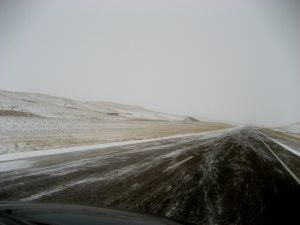 Soon the roads will be slicker than a skating rink and we want you and your families to stay safe, and avoid unnecessary car insurance claims.
Soon the roads will be slicker than a skating rink and we want you and your families to stay safe, and avoid unnecessary car insurance claims.
Driving in winter weather — ice, sludge, and snow, can create a challenging situation for many drivers. To reduce your chances of mishap on the roads, the following tips will help you to better handle winter driving conditions.
For an updated guide, checkout the ultimate winter road safety guide.
Emergency Car Kit:
Before you venture out, you should have the following items in your vehicle at ALL times:
- First aid kit
- Map/GPS
- Cell phone (even without a service plan, they still work to place Emergency 911 calls)
- Cell phone charger
- Towing and battery boosting cables
- Blanket (x2)
- Water
- Non-perishable food items
- Flashlight
- Snow brush
- Ice Scraper
- Folding shovel
- Winter gloves
- Windshield washer fluid
- Bag of sand
- Candle(s)
- Matches
- Warning triangle
- Flares
- Emergency “HELP” sign
1. Try to have a full gas tank. If you are stuck somewhere and your car can still run, your heater could make the difference between life and death. The more gas you have, the longer your car will be able to run (and keep you warm) until help arrives. Also, if you are in a situation where you need to keep your car running, be sure to clean your vehicle’s exhaust pipe every 30 minutes. An excess of snow or ice could block your tailpipe, exhausting toxic gases into your vehicle. This could lead to carbon monoxide poisoning.
2. Winterize your vehicle. Equipping your vehicle with the tools necessary to survive the winter commute is vital. This includes: installing good windshield wiper blades, checking your car battery, making sure the heater and defroster are working properly, and installing winter tires. Snow/ice tires maintain elasticity and gripping power in low temperatures, whereas “all season” tires tend to harden in cold weather, reducing friction. Also, be sure to check the treads and air pressure of your tires regularly.
3. Clean your windows. When your vehicle is covered with snow or ice, carefully clean all of the windows and mirrors before setting out in the morning. Be sure to also brush the snow off your front and rear lights. If you’re on a long trip or it’s particularly slushy, make sure you clean your lights whenever you stop for gas.
4. Be vigilant. Try to look far ahead to identify hazards. If you know what you’re driving towards, you can adequately prepare to slow down or stop. Some common hazards are:
- Green lights at intersections that have been green a long time. Checking the status of the walk/don’t walk signals as you approach them will help you decide what action to take (if it’s flashing, your green light is about to turn red).
- Stop signs at T-intersections, even if you have the right of way. Just because another driver encounters a stop sign, doesn’t mean that they are able to stop. Be sure to look in all directions for vehicles that may not be able to stop.
- Multiple brake lights coming on ahead. This signifies that there could be something dangerous ahead.
- Bridges, bends in the road, or winding roads. Roads like these are prone to icing.
5. Test your brakes. First, check to make sure that there are no cars behind you and then gently apply some pressure to your brakes. If the car slides or if you feel the ABS activating, it is a good sign that you need to slow down and adjust your driving accordingly.
6. Avoid slush and ice. During a heavy snowfall, cars travelling on the road will often cause ridges of slush and/or ice between the lanes. Here are some helpful tips to help you drive through a ridge safely:
- Try to pick a spot where there is the least amount of slush or ice between lanes and signal your lane change well in advance.
- Do not accelerate. Gently easing off the gas while switching lanes will reduce the chances of your vehicle fishtailing and losing control.
- Hold the steering wheel firmly as you cross from one lane to the next. Although the lane you are currently travelling on may be clear and has good traction, changing lanes through that ridge of slush or ice can dramatically upset the vehicle.
7. Drive in the slow lane. If you know the roads are slippery and there is a vehicle that you feel is too close behind you, stay in the right hand lane, slow down, or move to the side and let them pass. Don’t feel pressured to speed up by an aggressive driver. The left hand lane should only be used for passing.
8. Do not use cruise control. If your vehicle slows down, the cruise control may cause the engine to “race” unintentionally and cause the vehicle to lose control.
9. Have complete control of your vehicle. Understanding how to operate your vehicle on an icy road or in a snowstorm is crucial. Using the following tips and techniques could help save your life:
Controlling a skid
- First and foremost, do not panic!
- Look the direction that you want your vehicle to go, and steer in that same direction
- Do not brake
- Do not accelerate
- If you’re using automatic transmission, shift to neutral, however, if you cannot do that right away, do not change the gear at all
- If you’re using manual transmission, declutch
Braking on a slippery road?
The most efficient techniques for braking on an icy road is squeeze braking (also known as threshold braking) along with declutching (manual transmission) or shifting to neutral (automatic transmission). Drive according to the road conditions and try to avoid hitting your brakes with too much force.
10. Avoid driving in bad weather. The best way to avoid an accident is to not be there. If the conditions are poor, delay your trip or cancel, if possible. Before leaving on a planned trip, check the current driving conditions. You can listen to your local radio station or refer to a website such as www.theweathernetwork.com for winter driving conditions.






